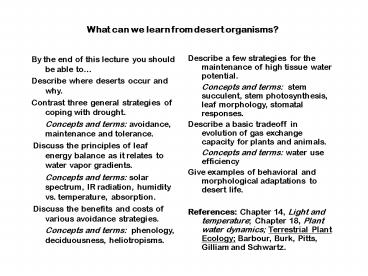What can we learn from desert organisms - PowerPoint PPT Presentation
1 / 33
Title: What can we learn from desert organisms
1
What can we learn from desert organisms?
By the end of this lecture you should be able
to Describe where deserts occur and
why. Contrast three general strategies of coping
with drought. Concepts and terms avoidance,
maintenance and tolerance. Discuss the
principles of leaf energy balance as it relates
to water vapor gradients. Concepts and terms
solar spectrum, IR radiation, humidity vs.
temperature, absorption. Discuss the benefits
and costs of various avoidance strategies.
Concepts and terms phenology, deciduousness,
heliotropisms.
- Describe a few strategies for the maintenance of
high tissue water potential. - Concepts and terms stem succulent, stem
photosynthesis, leaf morphology, stomatal
responses. - Describe a basic tradeoff in evolution of gas
exchange capacity for plants and animals. - Concepts and terms water use efficiency
- Give examples of behavioral and morphological
adaptations to desert life. - References Chapter 14, Light and temperature
Chapter 18, Plant water dynamics Terrestrial
Plant Ecology Barbour, Burk, Pitts, Gilliam and
Schwartz.
2
North American Deserts
3
Sonoran Desert
4
The Great Basin Desert
5
Atriplex hymenelytra in the desert southwest
6
Eriogonum robustum, altered andesite buckwheat,
near Reno, Nevada
7
Mormon tea
8
Mormon tea in the desert southwest. Where are
the leaves?
9
(No Transcript)
10
(No Transcript)
11
(No Transcript)
12
(No Transcript)
13
General strategies for responding to low water
availability
- avoidance
- phenology
- life history
- daily activity pattern
- migration
- maintenance
- reduce water loss
- tolerance
- invertebrates and bryophytes
14
(No Transcript)
15
(No Transcript)
16
(No Transcript)
17
(No Transcript)
18
(No Transcript)
19
Desert holly Atriplex hymenelytra Chenopodiaceae
http//www.clunet.edu/wf/des/flowers/fwr-461.htm
20
green
green
white
21
Salt glands on an Atriplex leaf.
22
(No Transcript)
23
Root distribution of some prairie plants- the
maintenance of a high root/shoot ratio is an
important adaptation to drought.
From Kramer
24
Banksia spinulosa leaf the cuticle is stained
orange.
25
Problems of being a desert animal
- food may be limited
- not enough water
- if its hot, you may need to use water for
evaporative cooling - too hot - you die
26
Behavioral strategies for avoidance
- be nocturnal or crepuscular
- or confine activities to the coolest part of the
day - go underground
-soil temperatures are cooler and more stable
than surface temperatures
27
Soil temperatures are typically moderate and
stable
28
Morphological specializations
- greatly-lengthened Henles loop in kidney
- produce a highly concentrated urine
- convoluted, narrow nasal passages
- reduce respiratory water loss by condensation in
nose - can produce dry feces
- reduce water loss from digestive system
- feet modified for digging (fossorial)
- can select cooler habitat
- specializations for evaporative cooling
- sweat glands, panting
29
Allens Rule - 1877
- extremities (limbs, tails, ears) are longer in
warm climates than in cold-climates because they
act as heat-radiating organs
30
(No Transcript)
31
Kangaroo rats
- exhibit many of the most common desert animal
specializations - speciose and abundant - very successful
- do not use evaporative cooling, so water budgets
can be easily calculated - small, easily studied in the lab
- pioneering studies of Knut Schmidt-Nielsen at
Duke University - drink no water
32
Oxidation water
e.g. C6H12O6 6 O2 to 6 CO2 6 H20
33
Water budget for a kangaroo rat































